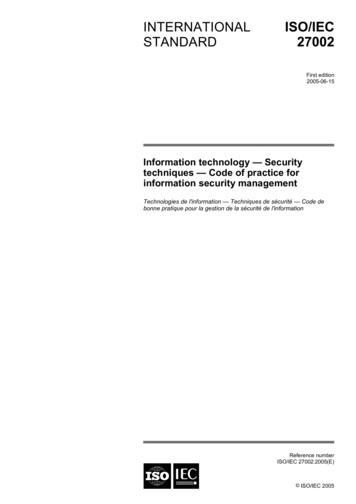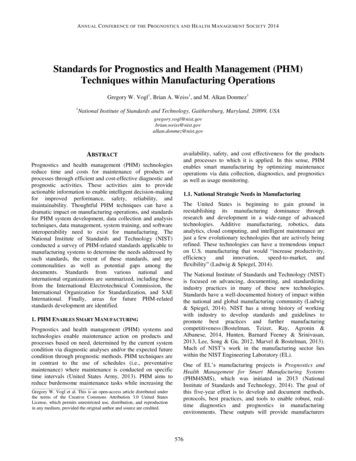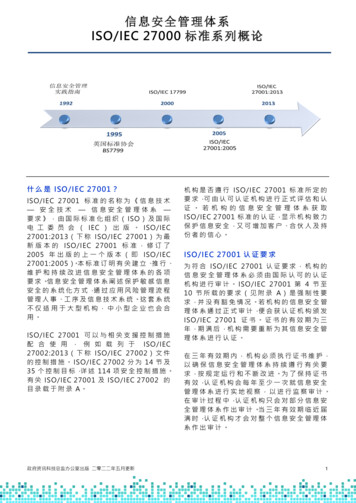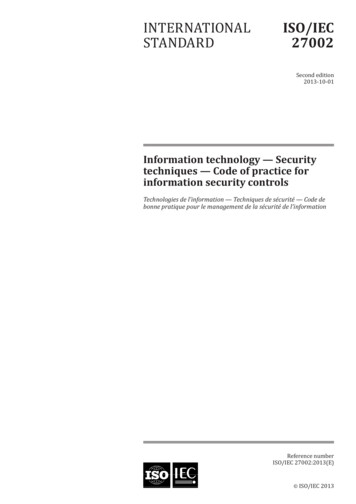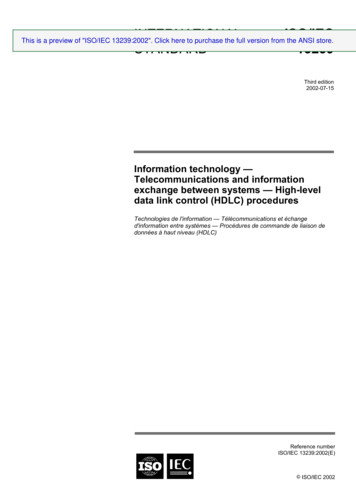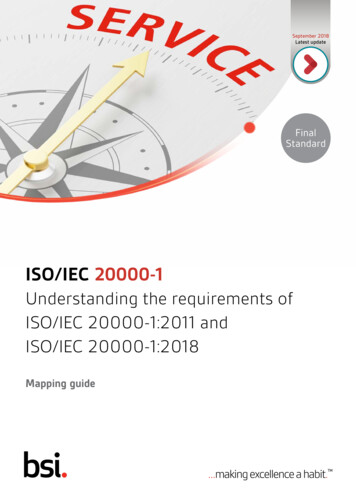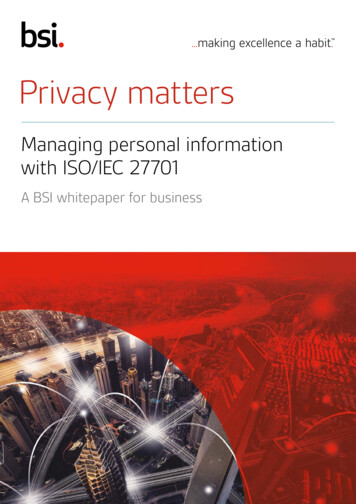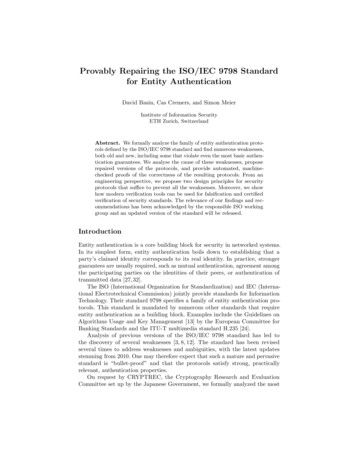
Transcription
Provably Repairing the ISO/IEC 9798 Standardfor Entity AuthenticationDavid Basin, Cas Cremers, and Simon MeierInstitute of Information SecurityETH Zurich, SwitzerlandAbstract. We formally analyze the family of entity authentication protocols defined by the ISO/IEC 9798 standard and find numerous weaknesses,both old and new, including some that violate even the most basic authentication guarantees. We analyse the cause of these weaknesses, proposerepaired versions of the protocols, and provide automated, machinechecked proofs of the correctness of the resulting protocols. From anengineering perspective, we propose two design principles for securityprotocols that suffice to prevent all the weaknesses. Moreover, we showhow modern verification tools can be used for falsification and certifiedverification of security standards. The relevance of our findings and recommendations has been acknowledged by the responsible ISO workinggroup and an updated version of the standard will be released.IntroductionEntity authentication is a core building block for security in networked systems.In its simplest form, entity authentication boils down to establishing that aparty’s claimed identity corresponds to its real identity. In practice, strongerguarantees are usually required, such as mutual authentication, agreement amongthe participating parties on the identities of their peers, or authentication oftransmitted data [27, 32].The ISO (International Organization for Standardization) and IEC (International Electrotechnical Commission) jointly provide standards for InformationTechnology. Their standard 9798 specifies a family of entity authentication protocols. This standard is mandated by numerous other standards that requireentity authentication as a building block. Examples include the Guidelines onAlgorithms Usage and Key Management [13] by the European Committee forBanking Standards and the ITU-T multimedia standard H.235 [24].Analysis of previous versions of the ISO/IEC 9798 standard has led tothe discovery of several weaknesses [3, 8, 12]. The standard has been revisedseveral times to address weaknesses and ambiguities, with the latest updatesstemming from 2010. One may therefore expect that such a mature and pervasivestandard is “bullet-proof” and that the protocols satisfy strong, practicallyrelevant, authentication properties.On request by CRYPTREC, the Cryptography Research and EvaluationCommittee set up by the Japanese Government, we formally analyzed the most
recent versions of the protocols specified in parts 1–4 of the ISO/IEC 9798standard using the Scyther tool [9]. To our surprise, we not only found thatseveral previously reported weaknesses are still present in the standard, butwe also found new weaknesses. In particular, many of the protocols guaranteeonly weak authentication properties and, under some circumstances, even noauthentication at all. For the majority of implementations of the standard whereonly weak authentication is required, these weaknesses will not lead to securitybreaches. However, our findings clearly show that the guarantees provided bythe protocols are much weaker than might be expected. Moreover, in some cases,additional assumptions are required to ensure even the weakest possible form ofauthentication.We analyze the shortcomings in the protocols’ design and propose repairs.We justify the correctness of our fixes by providing machine-checked proofs of therepaired protocols. These proofs imply the absence of logical errors: the repairedprotocols provide strong authentication properties in a Dolev-Yao model, evenwhen multiple protocols from the standard are run in parallel using the same keyinfrastructure. Consequently, under the assumption of perfect cryptography, therepaired protocols guarantee strong authentication.To generate the correctness proofs, we first extend the Scyther-Prooftool [31] to handle bidirectional keys. We then use the tool to generate proofscripts that are checked independently by the Isabelle/HOL theorem prover. Asinput, Scyther-Proof takes a description of a protocol and its properties andproduces a proof in higher-order logic of the protocol’s correctness. Both thegeneration of proof scripts and their verification by Isabelle/HOL are completelyautomatic.From an engineering perspective, we observe that applying existing principlesfor constructing cryptographic protocols such as those of Abadi and Needham [2]would not have prevented most of the discovered weaknesses. We thereforeadditionally propose two design principles in the spirit of [2] whose applicationwould have prevented all of the weaknesses.Based on our analysis, the ISO/IEC working group responsible for the 9798standard will release an updated version of the standard, incorporating ourproposed fixes.Summary of Contributions. First, we find previously unreported weaknesses inthe most recent version of the ISO/IEC 9798 standard. Second, we repair thispractically relevant standard, and provide machine-checked proofs of the correctness of the repairs. Third, we propose two principles for engineering cryptographicprotocols in the spirit of [2] that would have prevented the weaknesses. Fourth,our work highlights how modern security protocol analysis tools can be used forfalsification and machine-checked verification of security standards.Organization. In Section 1, we describe the ISO/IEC 9798 standard. In Section 2,we model the protocols and analyze them, discovering numerous weaknesses. InSection 3, we analyze the sources of these weaknesses and present two designprinciples that eliminate them. In Section 4, we explain how we automatically2
generate machine-checked correctness proofs for these repaired protocols. Wedescribe related work in Section 5 and conclude in Section 6.11.1The ISO/IEC 9798 StandardOverviewWe give a brief overview of the standard, which specifies a family of entityauthentication protocols. We consider here the first four parts of the standard.Part 1 is general and provides background for the other parts. The protocols aredivided into three groups. Protocols using symmetric encryption are described inPart 2, those using digital signatures are described in Part 3, and those usingcryptographic check functions such as MACs are described in Part 4.Because the standard has been revised, we also take into account the mostrecent technical corrigenda and amendments. Our analysis covers the protocolsspecified by the following documents. For the first part of the standard, we coverISO/IEC 9798-1:2010 [21]. For the second part, we cover ISO/IEC 9798-2:2008 [18]and Corrigendum 1 from 2010 [22]. For the third part, we cover ISO/IEC 97983:1998 [16], the corrigendum from 2009 [19], and the amendment from 2010 [23].Finally, for the fourth part, our analysis covers ISO/IEC 9798-4:1999 [17] andthe corrigendum from 2009 [20].Table 1 lists the 17 associated protocols. For each cryptographic mechanism,there are unilateral and bilateral authentication variants. The number of messagesand passes differs among the protocols as well as the communication structure.Some of the protocols also use a trusted third party (TTP).Note that there is no consistent protocol naming scheme shared by the differentparts of the ISO/IEC 9798 standard. The symmetric-key based protocols arereferred to in [18] as “mechanism 1”, “mechanism 2”, etc., whereas the protocolsin [16, 20, 23] are referred to by their informal name, e. g., “One-pass unilateralauthentication”. In this paper we will refer to protocols consistently by combiningthe document identifier, e. g., “9798-2” with a number n to identify the n-thprotocol in that document. For protocols proposed in an amendment, we continuethe numbering from the base document. Hence we refer to the first protocolin [23] as “9798-3-6”. The resulting identifiers are listed in Table 1.Most of the protocols are parameterized by the following elements:– All text fields included in the protocol specification are optional and theirpurpose is application-dependent.– Many fields used to ensure uniqueness or freshness may be implementedeither by random numbers, sequence numbers, or timestamps.– Some protocols specify alternative message contents.– Some identifier fields may be dropped, depending on implementation details.1.2NotationWe write X Y to denote the concatenation of the bit strings X and Y . We writesign{ X }enck to denote the encryption of X with the symmetric key k and { X }k3
Protocol DescriptionPart 2: Symmetric-key Cryptography9798-2-1 One-pass unilateral authentication9798-2-2 Two-pass unilateral authentication9798-2-3 Two-pass mutual authentication9798-2-4 Three-pass mutual authentication9798-2-5 Four-pass with TTP9798-2-6 Five-pass with TTPPart 3: Digital Signatures9798-3-1 One-pass unilateral authentication9798-3-2 Two-pass unilateral authentication9798-3-3 Two-pass mutual authentication9798-3-4 Three-pass mutual authentication9798-3-5 Two-pass parallel mutual authentication9798-3-6 Five-pass mutual authentication with TTP, initiated by A9798-3-7 Five-pass mutual authentication with TTP, initiated by BPart 4: Cryptographic Check Functions9798-4-1 One-pass unilateral authentication9798-4-2 Two-pass unilateral authentication9798-4-3 Two-pass mutual authentication9798-4-4 Three-pass mutual authenticationTable 1. Protocols specified by Parts 1-4 of the standard.to denote the digital signature of X with the signature key k. The application ofa cryptographic check function f , keyed with key k, to a message m, is denotedby fk (m).In the standard, TVP denotes a Time-Variant Parameter, which may be asequence number, a random value, or a timestamp. TN denotes a time stampor sequence number. IX denotes the identity of agent X. Text n refers to a textfield. These fields are always optional and their use is not specified within thestandard. We write KAB to denote the long-term symmetric key shared by Aand B. If the key is directional, we assume that A uses KAB to communicatewith B and that B uses KBA . By convention, we use lower case strings for freshsession keys, like kab.1.3Protocol ExamplesExample 1: 9798-4-3. The 9798-4-3 protocol is a two-pass mutual authentication protocol based on cryptographic check functions, e. g., message authenticationcodes. Its design, depicted in Figure 1, is similar to two related protocols basedon symmetric key encryption (9798-2-3) and digital signatures (9798-3-3).The initiator starts in role A and sends a message that consists of a timestamp or sequence number TNA , concatenated with an optional text field and a4
1. A B : TNA Text 2 fKAB (TNA IB Text 1 )2. B A : TNB Text 4 fKAB (TNB IA Text 3 )Fig. 1. The 9798-4-3 two-pass mutual authentication protocol using a cryptographiccheck function.encToken PA Text 4 { TVPA kab IB Text 3 }encKAP { TNP kab IA Text 2 }KBPencencToken AB Text 6 { TNP kab IA Text 2 }KBP { TNA IB Text 5 }kabToken BA Text 8 { TNB IA Text 7 }enckab1.2.3.4.A P :P A:A B:B A:TVPA IB Text 1Token PAToken ABToken BAFig. 2. The 9798-2-5 four pass protocol with TTP using symmetric encryption.cryptographic check value. This check value is computed by applying a cryptographic check function to the key shared between A and B and a string consistingof TNA , B’s identity, and optionally a text field Text 1 . When B receives thismessage he computes the cryptographic check himself and compares the resultwith the received check value. He then computes the response message in a similarway and sends it to A, who checks it.Example 2: 9798-2-5. Figure 2 depicts the 9798-2-5 protocol, which is basedon symmetric-key encryption and uses a Trusted Third Party. A first generates atime-variant parameter TVPA (which must be non-repeating), and sends it withB’s identity IB and optionally a text field to the trusted party P . P then generatesa fresh session key kab and computes Token PA , which essentially consists of twoencrypted copies of the key, using the long-term shared keys between P andA, and P and B, respectively. Upon receiving Token PA , A decrypts the firstpart to retrieve the session key, and uses the second part to construct Token AB .Finally, B retrieves the session key from this message and sends his authenticationmessage Token BA to A.1.4Optional Fields and VariantsThere are variants for each protocol listed in Table 1. Each protocol contains textfields, whose purpose is not specified, and which may be omitted, giving rise toanother protocol variant. As can be seen in the previous examples, some of thesetext fields are plaintext, whereas others are within the scope of cryptographicoperations (i. e., signed, encrypted, or cryptographically checked). Note that thestandard does not provide a rationale for choosing among these options.In setups where symmetric keys are used, it is common that if Alice wants tocommunicate with Bob, she will use their shared key, which is the same key thatBob would use to communicate with Alice. Such keys are called bidirectional.5
Alternatively one can use unidirectional keys where each pair of agents shares twosymmetric keys, one for each direction. In this case KAlice,Bob and KBob,Alice aredifferent. For some protocols that employ symmetric keys, the standard specifiesthat if unidirectional keys are used, some identity fields may be omitted fromthe encrypted (or checked) payload. This yields another variant.The two protocols 9798-3-6 and 9798-3-7 both provide two options for thetokens included in their messages, giving rise to further variants. Note that inSection 4 we verify corrected versions of all 17 protocols in Table 1, taking allvariants into account.1.5Threat Model and Security PropertiesThe ISO/IEC 9798 standard neither specifies a threat model nor defines thesecurity properties that the protocols should satisfy. Instead, the introductionof ISO/IEC 9798-1 simply states that the protocols should satisfy mutual orunilateral authentication. Furthermore, the following attacks are mentioned asbeing relevant: man-in-the-middle attacks, replay attacks, reflection attacks, andforced delay attacks. We note that the standard does not explicitly claim thatany of the protocols are resilient against the above attacks.2Protocol AnalysisWe use two different analysis tools. In this section, we use the Scyther tool [9]to find attacks on the ISO/IEC 9798 protocols. In Section 4, we will use therelated Scyther-Proof tool [31] to generate machine-checked proofs of thecorrected versions.Scyther performs an automatic analysis of security protocols in a Dolev-Yaostyle model, for an unbounded number of instances. It is very efficient at bothverification and falsification, in particular for authentication protocols such asthose considered here. Using Scyther, we performed protocol analysis withrespect to different forms of authentication. We explain these forms below whendiscussing particular protocols.Our analysis reveals that the majority of the protocols in the standard ensureweak entity authentication. However, we also found attacks on five protocols andtwo protocol variants. These attacks fall into the following categories: role-mixupattacks, type flaw attacks, multiple-role TTP attacks, and reflection attacks. Inall cases, when an agent finishes his role of the protocol, the protocol has not beenexecuted as expected, which can lead the agent to proceed on false assumptionsabout the state of the other involved agents.In Table 2 we list the attacks we found using Scyther. The rows list theprotocols, the properties violated, and any additional assumptions required forthe attacks. We have omitted in the table all attacks that are necessarily entailedby the attacks listed. For example, since 9798-2-5 does not satisfy aliveness fromB’s perspective, it also does not satisfy any stronger properties such as (weak)agreement. We now describe the classes of attacks in more detail.6
ProtocolViolated 798-2-3-udkey9798-2-59798-2-59798-2-69798-2-6A Agreement(B,TNB,Text3)B Agreement(A,TNA,Text1)A Agreement(B,TNB,Text3)B Agreement(A,TNA,Text1)A AliveB AliveA AliveB Alive9798-3-39798-3-39798-3-7-1A Agreement(B,TNB,Text3)B Agreement(A,TNA,Text1)A Agreement(B,Ra,Rb,Text8) keyA Agreement(B,TNb,Text3)B Agreement(A,TNa,Text1)A Agreement(B,TNb,Text3)B Agreement(A,TNa,Text1)Alice-talks-to-AliceTable 2. Overview of attacks found.2.1Role-Mixup AttacksSome protocols are vulnerable to a role-mixup attack in which an agent’s assumptions on another agent’s role are wrong. Many relevant forms of strongauthentication, such as agreement [27], matching conversations [4] or synchronisation [10], require that when Alice finishes her role apparently with Bob, thenAlice and Bob not only agree on the exchanged data, but additionally Alice canbe sure that Bob was performing in the intended role. Protocols vulnerable torole-mixup attacks violate these strong authentication properties.Figure 3 on the following page shows an example of a role-mixup attack onthe 9798-4-3 protocol from Figure 1. Agents perform actions such as sending andreceiving messages, resulting in message transmissions represented by horizontalarrows. Actions are executed within threads, represented by vertical lines. Thebox at the top of each thread denotes the parameters involved in the thread’screation. Claims of security properties are denoted by hexagons and a crossed-outhexagon denotes that the claimed property is violated.In this attack, the adversary uses a message from Alice in role A (thread 1)to trick Alice in role B (thread 3) into thinking that Bob is executing role A andis trying to initiate a session with her. However, Bob (thread 2) is only replyingto a message provided to him by the adversary, and is executing role B. Theadversary thereby tricks Alice into thinking that Bob is in a different state thanhe actually is.Additionally, when the optional text fields Text 1 and Text 3 are used, therole-mixup attack also violates the agreement property with respect to thesefields: Alice will end the protocol believing that the optional field data she receivesfrom Bob was intended as Text1, whereas Bob actually sent this data in the7
mscthread 1thread 2thread 3role Aexecuted by Aliceinitiating with Bobrole Bexecuted by Bobresponding to Alicerole Bexecuted by Aliceresponding to BobTNA Text 2 fKAlice,Bob (TNA IBob )TNB Text 4 fKAlice,Bob (TNB IAlice )TNB′ Text 4 fKAlice,Bob (TNB′ IBob )Agreement(Alice,Bob,TNB )Fig. 3. Role-mixup attack on 9798-4-3: when Alice finishes thread 3 she wrongly assumesthat Bob was performing the A role.Text3 field. Depending on the use of these fields, this can constitute a serioussecurity problem. Note that exploiting these attacks, as well as the other attacksdescribed below, does not require “breaking” cryptography. Rather, the adversaryexploits similarities among messages and the willingness of agents to engage inthe protocol.Summarizing, we found role-mixup attacks on the following protocols: 97982-3 with bi- or unidirectional keys, 9798-2-5, 9798-3-3, and 9798-4-3 with bi- orunidirectional keys.2.2Type Flaw AttacksSome protocol implementations are vulnerable to type flaw attacks where dataof one type is parsed as data of another type. Consider, for example, an implementation where agent names are encoded into bit-fields of length n, which isalso the length of the bit-fields representing nonces. It may then happen that anagent who expects to receive a nonce (any fresh random value that it has notseen before), therefore accepts a bit string that was intended to represent anagent name.Scyther finds such an attack on the 9798-3-7 protocol, also referred to as“Five pass authentication (initiated by B)” [23, p. 4]. In the attack, both (agent)Alice and (trusted party) Terence mistakenly accept the bit string correspondingto the agent name “Alice” as a nonce.2.3Attacks Involving TTPs that Perform Multiple RolesAnother class of attacks occurs when parties can perform both the role of thetrusted third party and another role. This scenario is not currently excluded bythe standard.In Figure 4 we show an attack on 9798-2-5, from Figure 2. The attack closelyfollows a regular protocol execution. In particular, threads 1 and 3 perform theprotocol as expected. The problem is thread 2. Threads 1 and 3 assume that the8
mscthread 1thread 2thread 3role Pexecuted by Peteassumes Alice in role Aassumes Bob in role Brole Aexecuted by Peteassumes Alice in role Passumes Bob in role Brole Bexecuted by Bobassumes Alice in role Aassumes Pete in role PTVPA IBob Text 1Token PA Text 4 { TVPA k IBob Text 3 }encKAP { TNP k IAlice Text 2 }encKBPToken PAToken AB Text 6 { TNP k IAlice Text 2 }encKBP { TNA IBob Text 5 }enckToken ABToken BAAliveness of AliceFig. 4. Attack on the 9798-2-5 protocol where the trusted third party Pete performsboth the P role and the A role. The assumptions of thread 1 and 3 agree. Bob wronglyconcludes that Alice is alive.participating agents are Alice (in the A role), Bob (in the B role), and Pete (inthe P role). From their point of view, Alice should be executing thread 2. Instead,thread 2 is executed by Pete, under the assumption that Alice is performing theP role. Thread 2 receives only a single message in the attack, which is Token PA .Because the long-term keys are symmetric, thread 2 cannot determine from thepart of the message encrypted with KAP that thread 1 has different assumptions.Thread 2 just forwards the other encrypted message part blindly to thread 3, asit does not expect to be able to decrypt it. Finally, thread 3 cannot detect theconfusion between Alice and Pete, because the information in Token AB that wasadded by thread 2 only includes Bob’s name.Summarizing, we found attacks involving TTPs that perform multiple roleson the 9798-2-5 and 9798-2-6 protocol.2.4Reflection AttacksReflection attacks occur when agents may start sessions communicating withthe same identity, a so-called Alice-talks-to-Alice scenario. The feasibility andrelevance of this scenario depends on the application and its internal checks.If an Alice-talks-to-Alice scenario is possible, some protocols are vulnerable toreflection attacks. The Message Sequence Chart in Figure 5 shows an example forthe 9798-4-3 protocol from Figure 1. In this attack, the adversary (not depicted)9
mscrole Aexecuted by AliceTNA Text2 fKAlice,Alice (TNA IAlice Text 1 )TNA Text4 fKAlice,Alice (TNA IAlice Text 1 )AgreementFig. 5. Reflection attack on 9798-4-3.reflects the time stamp (or nonce) and cryptographic check value from the messagesent by Alice back to the same thread, while prepending the message Text4. Thisattack violates one of the main requirements explicitly stated in the ISO/IEC9798-1 introduction, namely absence of reflection attacks.Summarizing, we found reflection attacks on the following protocols: 9798-2-3with bi- or unidirectional keys, 9798-2-5, 9798-3-3, and 9798-4-3 with bi- orunidirectional keys.33.1Repairing the ProtocolsRoot Causes of the ProblemsWe identify two shortcomings in the design of the protocols, which togetheraccount for all of the weaknesses detected.1) Cryptographic Message Elements May Be Accepted at Wrong Positions. Inboth the reflection and role mixup attacks, the messages that are received in aparticular step of a role were not intended to be received at that position. Bydesign, the protocol messages are all similar in structure, making it impossibleto determine at which point in the protocols the messages were intended to bereceived.As a concrete example, consider the reflection attack in Figure 5. Here, themessage sent in the protocol’s first step can be accepted in the second step, eventhough this is not part of the intended message flow.2) Underspecification of the Involved Identities and their Roles. As noted, thesymmetric-key based protocols with a TTP, 9798-2-5 and 9798-2-6, do notexplicitly state that entities performing the TTP role cannot perform other roles.Hence it is consistent with the standard for Alice to perform both the role of theTTP as well as role A or B. In these cases, the aliveness of the partner cannotbe guaranteed, as explained in Section 2.3. The source of this problem is thatone cannot infer from each message which identity is associated to which role.10
For example, consider the first encrypted component from the third messagein the 9798-2-5 protocol with bidirectional keys, in Figure 2.{ TNP kab IA Text 2 }encKBPThis message implicitly includes the identities of the three involved agents: theidentity of the agent performing the A role is explicitly included in the encryption,and the shared long-term key KBP implicitly associates the message to the keyshared between the agent performing the B and P roles. However, because thekey is bidirectional, the recipient cannot determine which of the two agents (say,Bob and Pete) sharing the key performed which role: either Bob performed the Brole and Pete the P role, or vice versa. Our attack exploits exactly this ambiguity.3.2Associated Design PrinciplesTo remedy these problems, we propose two principles for designing securityprotocols. These principles are in the spirit of Abadi and Needham’s elevenprinciples for prudent engineering practice for cryptographic protocols [2].Our first principle concerns tagging.Principle: positional tagging. Cryptographic message componentsshould contain information that uniquely identifies their origin. In particular, the information should identify the protocol, the protocol variant,the message number, and the particular position within the message,from which the component was sent.This is similar in spirit to Abadi and Needham’s Principle 1, which states that“Every message should say what it means: the interpretation of the message shoulddepend only on its content. It should be possible to write down a straightforwardEnglish sentence describing the content — though if there is a suitable formalismavailable that is good too.” Our principle does not depend on the meaning of themessage as intended by the protocol’s designer. Instead, it is based solely on thestructure of the protocol messages and their acceptance conditions.Note that we consider protocols with optional fields to consist of multipleprotocol variants. Thus, a message component where fields are omitted, shouldcontain information to uniquely determine which fields were omitted.Our second principle is a stricter version of Abadi and Needham’s Principle 3.Principle: inclusion of identities and their roles. Each cryptographic message component should include information about the identities of all the agents involved in the protocol run and their roles, unlessthere is a compelling reason to do otherwise.A compelling reason to leave out identity information might be that identityhiding is a requirement, i. e., Alice wants to hide that she is communicating withBob. However, such requirements can usually be met by suitably encryptingidentity information.11
Contrast this principle with the Abadi and Needham’s Principle 3: “If theidentity of a principal is essential to the meaning of a message, it is prudent tomention the principal’s name explicitly in the message.” The original principle isonly invoked when the identity is essential. Instead, we propose to always includeinformation on all the identities as well as their roles. This principle would haveprevented attacks on many protocols, including the attacks on the 9798-2-5 and9798-2-6 protocols, as well as the Needham-Schroeder protocol [26].For protocols with a fixed number of roles, this principle can be implementedby including an ordered sequence of the identities involved in each cryptographicmessage component, such that the role of an agent can be inferred from itsposition in the sequence.3.3Proposed Modifications to the StandardAll the previously mentioned attacks on the ISO/IEC 9798 can be prevented byapplying the previous two principles. Specifically, we propose three modificationsto the ISO standard, shown in Figure 6. The first two directly follow from theprinciples and the third modification restricts the use of two protocols in thestandard. Afterwards we give an example of a repaired protocol.Note that in this section we only give informal arguments why our modifications prevent the attacks. In Section 4, we provide machine-checked proofs thatthis is the case.Ensuring that Cryptographic Data Cannot Be Accepted at the WrongPoint. We factor the first principle (positional tagging) into two parts andpropose two corresponding amendments to the standard. First, we explicitlyinclude in each cryptographic message component constants that uniquely identifythe protocol, the message number, and the position within the message. Second,we ensure that protocol variants can be uniquely determined from the messages.In our first amendment, shown in Figure 6, we implement unique protocolidentifiers by using an existing part of the standard: the object identifier fromAnnex B of the standard, which specifies an encoding of a unique protocol identifier. We also introduce a unique identifier for the position of the cryptographiccomponent within the protocol.Amendment 1 prevents all reflection attacks because messages sent in onestep will no longer be accepted in another step. Furthermore, it prevents all rolemixup attacks, because the unique constants in the messages uniquely determinethe sending role. The final part of Amendment 1, stating that cryptographic keysshould not be used by other protocols, provides distinctness of cryptographicmessages with respect to any other protocols.Our second amendment, also shown in Figure 6, ensures that the protocolvariant (determined by the omission of optional field
scripts that are checked independently by the Isabelle/HOL theorem prover. As input, Scyther-Proof takes a description of a protocol and its properties and produces a proof in higher-order logic of the protocol's correctness. Both the generation of proof scripts and their veri cation by Isabelle/HOL are completely automatic.



